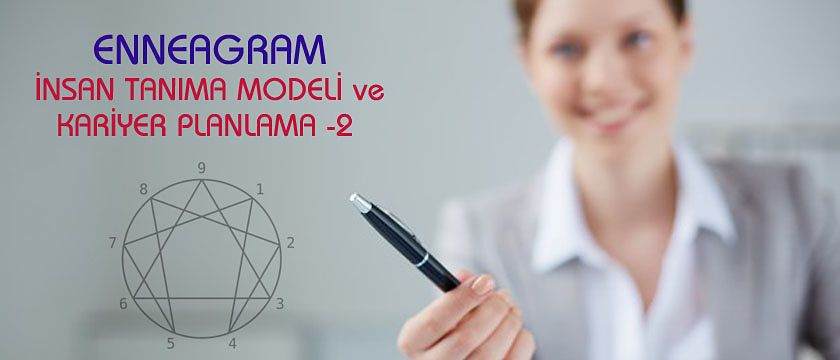
21 Tem
Enneagram Human Personality Model And Career Planning-2
The 9 Types of Personality:
There are 9 different basic personality types in the Human Model. 9 different basic personality types expresses 9 different views of life, 9 different ways of thinking and ways of doing business. None of the 9 different basic personality types has superiority over the other. Each personality has its own strengths and weaknesses. The Enneagram is a way of understanding a person’s behavior, based on their dominant characteristics and motivators. The differences within each basic personality motif make our world an interesting place and contribute our collective development. However, these differences also make it difficult to define the personalities briefly and clearly. The brief descriptions of the 9 types which describe the outlines of the personality motifs are as follows:
Persons whose emotional potential is dominant:
• Charitable: Care, Love, Need, Service, Relationship, Empathy, Ownership, Orientation, and Sympathy
• Focused on Success: Goal, Image, Motivation, Development, Production, Speed, Workaholic, Competition, Ambition,
• Original: Diversity, Art, Aesthetics, Design, Individuality, Intuition, Depth, Emotion, Melancholy
Persons whose mental potential is dominant:
• Researcher: Expertise, Knowledge, Observation, Understanding, Curiosity, Loneliness, Archiving, Objectivity, Privacy
• Loyal Interrogator: Measure, Trust, Commitment, Systematic, Worry, Mystery, Responsibility, Defense
• Discoverer: Optimism, Inspiration, Vision, Change, Extraordinariness, Innovation, Adventure, Insatiability, Pleasure
Persons whose physical potential is dominant:
• Ambitious: Justice, Power, Independence, Leadership, Brave, Protection, Courage, Action, and Intervention
• Peaceful: Harmony, Tranquility, Naturalness, Dialogue, Patience, Persistence, Persuasion, Solemnity, and Indecision
• Perfectionist: Ideal, Rule, Principle, Prudence, Detail, Order, Criticism, Tension, Objectivity
9 different basic personality traits are potentially present in every human being; but the dominant potential in everyone is different.
One of the 9 different personality types is the basic personality motif that reflects the personality of the individual.
The basic personality motif is the motif that dominates the whole personality.
People can acquire different personality traits according to their level, education, experience and model a different personality in their own lives.
One can add richness to life by gaining a different point of view of different personalities, but the basic personality motif does not change.
Developing a different viewpoint allows us to look at life and events from different perspectives.
It allows us to see and surround the truth from a 360-degree perspective, not at an angle of nine.
9 different personality motifs are a system that describes both the motives of one person and of different personalities.
4 Poles of Human and Basic Personality Functions:
The Zero Centered Human Model is a holistic model. Once a person's basic personality motif is identified, it sets out the basic personality functions that show the human's preferences at the four poles.
The four poles of the human being were first modeled by Swiss psychologist Carl G. Jung. These 4 poles include:
• Introversion / Extroversion
• Intuition / Five Senses
• Logic / Emotion
• Flexible / Stable
1- Introversion - Extroversion:
This dimension is related to where the person gets his / her energy. Inverts take their energy from their inner world, and extraverts take their energy from the outer world.
2- Intuition-Five Senses:
This dimension is related to whether the person obtains information with intuition or five senses. Intuitive people work by structuring information and attaches importance to intuition and inspiration. Those who gather information with their five senses are interested in concrete and objective things and pay attention to details.
3- Logic-Emotion:
This dimension shows whether a person acts with logic or emotion when processing information and making decisions.
4- Flexible-Stable:
This dimension determines whether the person's general attitude towards life is flexible and perceptive or determined and judgmental.
People of these 4 different dimensions have a certain tendency and preference. These tendencies and preferences have a determining effect on personality. Professional preferences of people with different preferences also differ. For example, introverts are comfortable with jobs where they can work alone, where there is not much contact with people. Extraverted people, on the other hand, like the things they interact and enjoy communicating with people more. An office job that provides satisfaction for an introverted person can be torment for an extroverted personality.
As a result, you should not make a Career Choice without knowing your dominant potential and preferences in basic personality functions. Personality and temperament knowledge is one of the basic building blocks of a right career choice. The Career Report which is given as a result of Zero Centered Personality Test which synthesizes 3 potentials and basic personality functions of human beings with a unique point of view is a serious and scientific tool for both getting to know yourself and making career choice.
As a result:
• The Zero Centered Human Model is based on 3 human potentials.
• It determines persons’ preferences at 4 poles.
• In this respect, it is a holistic, synthesizing and original model.
• It generates tailor-made solutions and presents the developmental map instead of general recommendations and recipes.

